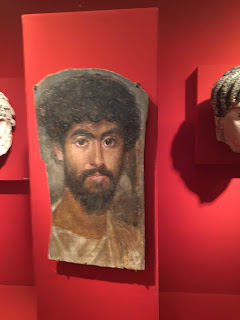The Egyptian wing is one of the iconic permanent exhibits of the Museum.
The Ancient Egyptian preoccupation with death has always fascinated me. The mummies and the process of creating them is all laid out in the Museum's storied halls in the expansive Egyptian wing.
One of the most beautifully somber exhibits is the hall with the Fayum mummy face masks. The mummy masks are named after the Fayum Basin where most of them were found. The style dates to the Coptic period and belongs to the tradition of panel painting.
What always impresses me is how young the subjects of these paintings are, and knowing that they are dead, I wonder whether they were idealized in death or whether they indeed had died so young and beautiful.
The Greek lettering on the mummy attests to how important the Greek language and culture were in the entire region at the time. It was called the Ptolemaic period and was created after the death of Alexander the Great by Ptolemy I. The Ptolemaic Kingdom fell to the Romans after the death of Kleopatra VII in 30 BC.
The small masks and statue are made in the style of Faience, which is this distinct shade of blue colored ceramics. Amazingly vivid after so many centuries!
This artful gold jewelry is also part of the display in that hall. I am awed at the mastery of those ancient artisans who created these masterpieces that survived time and could very easily be worn today, as their style is also eternal.
I guess eternal is the important concept here, because through this massive industry of death-art the people in these death portraits are forever enshrined in our minds.
It doesn't feel gloomy at all when I walk through those halls, it is more a celebration of the circle of life and death. I come here again and again and gaze into those brown eyes wondering who they were.
Enjoy!
Maria






















No comments:
Post a Comment